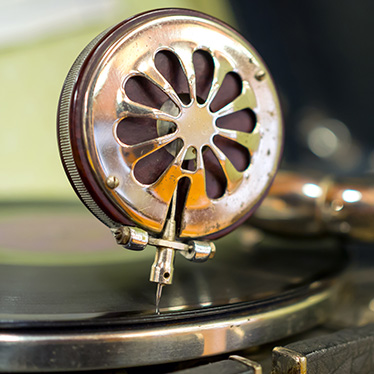How the Ability to Record Music Changed the Music Industry

Before recorded music was possible, people had little control or options over the music they could hear. For many centuries, external powers like the church or aristocracy commanded music – they directed its creation and performance.
During the Classical Period, the middle classes participated more in music through the expanded reach of public festivals, symphony performances, and private chamber concerts. Middle- and upper-class daughters learned instruments to perform as family entertainment. The working and lower classes also had access to performed music across time – from troubadours to folk music, anyone could sing and play simple instruments.
Yet, only having live music limited its reach and access. The advent of recorded music eliminated this restriction. The evidence shows how eager people were to have more music in their lives. Thomas Edison introduced his phonograph to the public in 1877. By 1915, Americans were spending $60 million a year on phonographs and records.
The broad availability, and market, for recorded music had a profound impact on all aspects of music:
Audiences had access to new music – recordings brought "high music" to the masses.
People who couldn't afford to attend symphonies or operas could now listen to them. One of the earliest hits was a 1903 recording of Enrico Caruso. His recordings sparked mass interest in opera in the early 20th century.
Musical genres hardened even as the number of identified genres grew.
With a buying audience for recorded music, people wanted to have an idea of what a song was before buying it. Different hits led to the naming of new genres of music, even if that musical type pre-existed recording. For example, a 1920 mega-hit recording by Mamie Smith of "Crazy Blues" established the "Blues" as a discrete musical genre.
Labels like "jazz" and "hillbilly" music entered the popular lexicon to communicate to audiences what a particular type of music a song was.
Composers began to create and arrange works with recording in mind.
The most famous example is Igor Stravinsky's Serenade in A (1925). In the early years of recorded music, a single recording could only last three minutes. Before recorded music, a movement might last anywhere from ten minutes to over an hour, depending on the form. Stravinsky composed four movements for his Serenade in A, each under three minutes. Thus, the entire work fit neatly into a two-disc package.
Early music producers cut down longtime blues and Appalachian songs that could go on for uncounted verses when sung live, to just a few verses. As recorded technology improved, longer recordings were possible. Thus, recordings of complete classical works from any era could generate mass appeal. Indeed, "classical music was the fastest-growing genre in 2018."
Longer tracks also allowed for the concept album era, which began in the mid-1960s and died sometime in the 21st century (that's a different story). So no blaming the average length of today's pop song, which is less than three minutes, on those early days of recorded music.
Broad access to recorded music inspired more people to learn to play an instrument.
Rather than intimidate people who could now hear the most skilled musicians perform, recorded music motivated them. In his book, "Capturing Sound," Mark Katz found that from 1890 to 1910, the number of music teachers and performers per capita rose by 25% in the United States. Recordings didn't just democratize access to listening to music. They democratized access to learning and playing music.
Set expectations on how a specific song should be played.
One challenge musicians talk about today is how tired they get performing the same song. Often they're bored with it. In other cases, they're frustrated that audiences define them by one song when they've moved on artistically. In classical music, having recordings of maestros and virtuosos is a double-edged sword. New generations can learn and be inspired by them. Yet these recordings also challenge them to interpret classical works in new ways. A modern interpretation can be original or get slammed as "derivative." Audiences listen to their favorite performances over and over. They may unfavorably compare a new performance simply because it's not what they expect, regardless of its artistic merit.
Recorded music had a deep impact on both the music industry and music culture. In the early years, advances in recording technology improved sound quality, such as allowing the capture of a true sound for instruments and voices in all registers.
Changes in recording technology continued to alter how music was recorded and thus, what kind of music could be produced. As technology has continued to advance, new ways of distributing and listening to music have developed. These innovations, most notably digital streaming, continue to impact when and how people listen to music.


